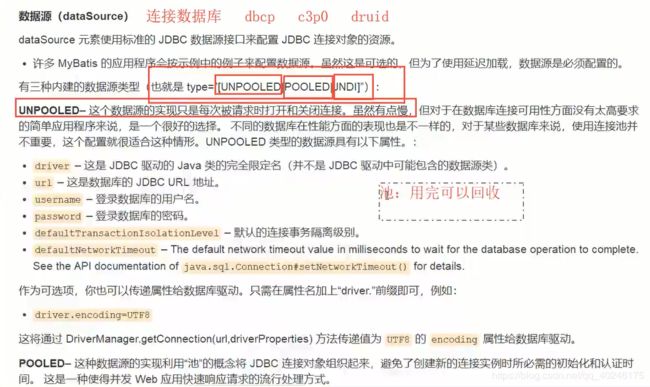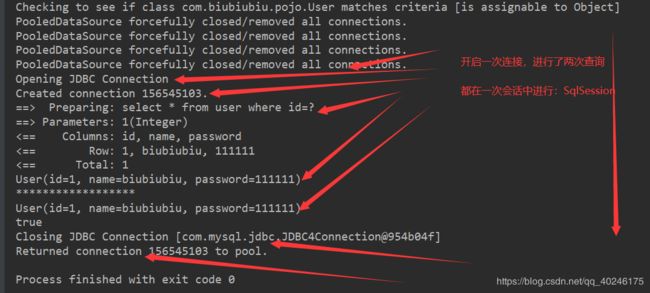MyBatis总结
本人精心整理,完全手敲的Mybatis学习笔记,我觉得,这篇笔记已经快把Mybatis官方文档都经过我自己理解整过来了。。包括我练习的源码,mybatis底层分析,概念等等,我觉得已经很全了。
虽然有点长,东西比较多,但是只要你细心看完这个Mybatis还不会的找我!!
觉得有用的,请多多支持博主,点赞关注~~
文章目录
- 1.简介
- 1.1、什么是Mybatis?
- 1.2、持久化
- 1.3、持久层
- 1.4、为什么需要Mybatis?
- 2.第一个Mybatis程序
- 2.1、搭建环境
- 2.2、创建一个模块
- 2.3、编写代码
- 2.4、测试
- 3.CRUD
- 3.1、namespace
- 3.2、select
- 3.3、insert
- 3.4、update
- 3.5、delete
- 3.6、常见错误
- 3.7、万能Map
- 3.8、模糊查询
- 4.配置解析
- 4.1、核心配置文件
- 4.2、环境配置(environments)
- 4.3、属性(properties)
- 4.4、类型别名(typeAliases)
- 4.5、设置
- 4.6、其他配置
- 4.7、映射器
- 4.8、生命周期和作用域
- 5.解决属性名和字段名不一致的问题
- 5.1、问题
- 5.2、resultMap
- 6、日志
- 日志工厂
- 6.2、Log4j
- 7、分页
- 7.1、使用Limit分页
- 7.2、RowBounds分页
- 7.3、分页插件
- 8、使用注解开发
- 8.1、面向接口编程
- 8.2、使用注解开发
- 8.3、CRUD
- 9、Lombok
- 10、多对一处理
- 测试环境
- 按照查询嵌套处理
- 按照结果嵌套处理
- 11、一对多处理
- 环境搭建
- 按照结果嵌套处理
- 按照查询嵌套处理
- 小节
- 12、动态SQL
- 搭建环境
- 动态IF
- 动态choose (when, otherwise)
- 动态trim, (where, set)
- SQL片段
- Foreach
- 13、缓存(了解)
- 13.1、简介
- 13.2、Mybatis缓存
- 13.3、一级缓存
- 13.4、二级缓存
- 13.5、缓存原理
- 13.6、自定义缓存-encache
1.简介
1.1、什么是Mybatis?
- MyBatis 是一款优秀的持久层框架。
- 它支持定制化 SQL、存储过程以及高级映射。
- MyBatis 避免了几乎所有的 JDBC 代码和手动设置参数以及获取结果集。
- MyBatis 可以使用简单的 XML 或注解来配置和映射原生类型、接口和 Java 的 POJO(Plain Old Java Objects,普通老式 Java 对象)为数据库中的记录。
- MyBatis 本是apache的一个开源项目iBatis, 2010年这个项目由apache software foundation 迁移到了google code,并且改名为MyBatis 。
- 2013年11月迁移到Github。
如何获得Mybatis?
- maven仓库
<!-- https://mvnrepository.com/artifact/org.mybatis/mybatis -->
<dependency>
<groupId>org.mybatis</groupId>
<artifactId>mybatis</artifactId>
<version>3.5.3</version>
</dependency>
- Github:https://github.com/mybatis/mybatis-3/releases
- 中文文档:https://mybatis.org/mybatis-3/zh/index.html
1.2、持久化
数据持久化
- 持久化就是将程序的数据在持久状态和瞬时状态转化的过程
- 内存:断电即失
- 数据库(JDBC),io文件持久化
为什么需要持久化?
- 因为有一些东西,不能让他丢掉。
- 还有就是内存太贵了,要是内存买的起,内存读取更香。
1.3、持久层
Dao层:持久层
Service层:业务操作
Controller层:接收用户的请求,并把请求转发给业务层去做
…
- 完成持久化工作的代码块
- 层界限十分明显
1.4、为什么需要Mybatis?
- 帮助程序员将数据存入到数据库中
- 方便
- 传统的JDBC代码太复杂了。简化。框架。自动化。
- 不用Mybatis也可以。只不过是更容易上手。
- 优点:
- 简单易学
- 灵活
- sql和代码的分离,提高了可维护性。
- 提供映射标签,支持对象与数据库的orm字段关系映射
- 提供对象关系映射标签,支持对象关系组建维护
- 提供xml标签,支持编写动态sql。
最重要的一点是:使用的人多。。。
Spring、SoringMVC、SpringBoot同理
2.第一个Mybatis程序
我用的是idea测试的,eclipse应该大差不差。
思路:搭建环境–>导入Mybatis–>编写代码–>测试!
2.1、搭建环境
搭建数据库
CREATE DATABASE mybatis;
USE mybatis;
CREATE TABLE USER(
id INT(20) NOT NULL PRIMARY KEY,
NAME VARCHAR(30) DEFAULT NULL,
pwd VARCHAR(30) DEFAULT NULL
)ENGINE=INNODB DEFAULT CHARSET=utf8;
INSERT INTO USER(id,NAME,pwd) VALUES
(1,'biubiubiu','111111'),
(2,'张三','123456'),
(3,'李四','654321')
新建项目
- 新建一个普通的maven项目
- 删除src目录(可以作为一个父工程)
- 导入maven依赖
<!-- 导入依赖 -->
<dependencies>
<!-- mysql驱动 -->
<dependency>
<groupId>mysql</groupId>
<artifactId>mysql-connector-java</artifactId>
<version>5.1.48</version>
</dependency>
<!-- mybatis -->
<dependency>
<groupId>org.mybatis</groupId>
<artifactId>mybatis</artifactId>
<version>3.5.3</version>
</dependency>
<!-- junit -->
<dependency>
<groupId>junit</groupId>
<artifactId>junit</artifactId>
<version>4.12</version>
</dependency>
</dependencies>
<!--在build 中配置resources,来防止我们资源导出失败的问题-->
<build>
<resources>
<resource>
<directory>src/main/resources</directory>
<includes>
<include>**/*.properties
**/ *.xml</include>
</includes>
<filtering>true</filtering>
</resource>
<resource>
<directory>src/main/java</directory>
<includes>
<include>**/*.properties
**/ *.xml</include>
</includes>
<filtering>true</filtering>
</resource>
</resources>
</build>
2.2、创建一个模块
- 编写mybatis的核心配置文件
<?xml version="1.0" encoding="UTF-8" ?>
<!DOCTYPE configuration
PUBLIC "-//mybatis.org//DTD Config 3.0//EN"
"http://mybatis.org/dtd/mybatis-3-config.dtd">
<!-- configuration核心配置文件 -->
<configuration>
<!-- 环境可以有多套,一般用默认的就行-->
<environments default="development">
<environment id="development">
<transactionManager type="JDBC"/>
<dataSource type="POOLED">
<property name="driver" value="com.mysql.jdbc.Driver"/>
<property name="url" value="jdbc:mysql://localhost:3306/database?useSSL=true&useUnicode=true&characterEncoding=UTF-8"/>
<property name="username" value="username"/>
<property name="password" value="password"/>
</dataSource>
</environment>
<!-- 自己创的test环境,暂时不用-->
<environment id="test">
<transactionManager type="JDBC"/>
<dataSource type="POOLED">
<property name="driver" value="${driver}"/>
<property name="url" value="${url}"/>
<property name="username" value="${username}"/>
<property name="password" value="${password}"/>
</dataSource>
</environment>
</environments>
<!--每一个Mapper.xml都需要在Mybatis核心配置文件中注册!!!-->
<mappers>
<mapper resource="com/biubiubiu/mapper/UserMapper.xml"/>
</mappers>
</configuration>
- 编写mybatis的工具类
package com.biubiubiu.utils;
import org.apache.ibatis.io.Resources;
import org.apache.ibatis.session.SqlSession;
import org.apache.ibatis.session.SqlSessionFactory;
import org.apache.ibatis.session.SqlSessionFactoryBuilder;
import java.io.IOException;
import java.io.InputStream;
/**
* 工具类:sqlSessionFactory --> sqlSession
* @author biubiubiu
*/
public class MybatisUtils {
private static SqlSessionFactory sqlSessionFactory;
static {
try {
//使用Mybatis第一步:获取SqlSessionFactory对象
String resource = "mybatis-config.xml";
InputStream inputStream = Resources.getResourceAsStream(resource);
sqlSessionFactory = new SqlSessionFactoryBuilder().build(inputStream);
} catch (IOException e) {
e.printStackTrace();
}
}
//既然有了 SqlSessionFactory,顾名思义,我们就可以从中获得 SqlSession 的实例了。
//SqlSession 完全包含了面向数据库执行 SQL 命令所需的所有方法。
//你可以通过 SqlSession 实例来直接执行已映射的 SQL 语句。
/**
* @return sqlSession
*/
public static SqlSession getSqlSession(){
return sqlSessionFactory.openSession();
}
}
2.3、编写代码
- 实体类
package com.biubiubiu.pojo;
import lombok.AllArgsConstructor;
import lombok.Data;
import lombok.NoArgsConstructor;
/**
* 实体类
* @author biubiubiu
*/
@Data
@AllArgsConstructor
@NoArgsConstructor
public class User {
private int id;
private String name;
private String pwd;
@Override
public String toString() {
return "User{" +
"id=" + id +
", name='" + name + '\'' +
", pwd='" + pwd + '\'' +
'}';
}
}
- 原Dao层Mapper接口
package com.biubiubiu.mapper;
import com.biubiubiu.pojo.User;
import java.util.List;
/**
* @author biubiubiu
*/
public interface UserMapper {
List<User> getUserList();
}
- 接口实现类:由原来的impl转变为一个Mapper.xml配置文件
<?xml version="1.0" encoding="UTF-8" ?>
<!DOCTYPE mapper
PUBLIC "-//mybatis.org//DTD Mapper 3.0//EN"
"http://mybatis.org/dtd/mybatis-3-mapper.dtd">
<!--namespace=绑定一个对应的Mapper接口-->
<mapper namespace="com.biubiubiu.mapper.UserMapper">
<!--select查询语句-->
<select id="getUserList" resultType="com.biubiubiu.pojo.User">
select * from mybatis.user
</select>
</mapper>
2.4、测试
注意点:
org.apache.ibatis.binding.BindingException:Type interface com.biubiubiu.mapper.UserMapper is not known to the MapperRegistry.
MapperRegistry是什么?
核心配置文件中注册 mappers
- junit测试
package com.biubiubiu.mapper;
import com.biubiubiu.pojo.User;
import com.biubiubiu.utils.MybatisUtils;
import org.apache.ibatis.session.SqlSession;
import org.junit.Test;
import java.util.List;
/**
* User测试类
* @author biubiubiu
*/
public class UserMapperTest {
@Test
public void test(){
//1、获得SqlSession对象
SqlSession sqlSession = MybatisUtils.getSqlSession();
//2、执行SQL
//方式一:getMapper
UserMapper mapper = sqlSession.getMapper(UserMapper.class);
List<User> userList = mapper.getUserList();
for(User user : userList){
System.out.println(user);
}
//关闭SqlSession
sqlSession.close();
}
}
第一次配置可能会遇到的问题:
1.配置文件没有注册
2.绑定接口错误。
3.方法名不对
4.返回类型不对
5.Maven导出资源问题(修改pom)
3.CRUD
3.1、namespace
namespace中的包名要和Dao/mapper接口的包名一致。
3.2、select
选择、查询语句:
- id:就是对应的namespace中的方法名。
- resultType:Sql语句执行的返回值。(大部分是实体类)
- parameterType:参数的类型。
1.编写接口定义的方法
/**
* 查询所有用户
* @return
*/
List<User> getUserList();
/**
* 根据ID查询用户
* @param id
* @return
*/
User getUserById(int id);
2.编写对应mapper中的sql语句
<!--select查询语句-->
<select id="getUserList" resultType="com.biubiubiu.pojo.User">
select * from mybatis.user
</select>
<select id="getUserById" parameterType="int" resultType="com.biubiubiu.pojo.User">
select * from mybatis.user where id =#{id}
</select>
3.测试
@Test
public void allUser(){
//1、获得SqlSession对象
SqlSession sqlSession = MybatisUtils.getSqlSession();
//2、执行SQL
//方式一:getMapper
UserMapper mapper = sqlSession.getMapper(UserMapper.class);
List<User> userList = mapper.getUserList();
for(User user : userList){
System.out.println(user);
}
// //方式二:不推荐使用,了解即可
// List userList2 = sqlSession.selectList("com.biubiubiu.dao.UserMapper.getUserList");
//
// for (User user : userList2) {
// System.out.println(user);
// }
//关闭SqlSession
sqlSession.close();
}
@Test
public void getUserById(){
SqlSession sqlSession = MybatisUtils.getSqlSession();
UserMapper mapper = sqlSession.getMapper(UserMapper.class);
User user = mapper.getUserById(1);
System.out.println(user);
sqlSession.close();
}
3.3、insert
/**
* 添加一个用户
* @param user
* @return
*/
int addUser(User user);
<!--insert插入语句,插入没有返回值resultType-->
<!--对象中的属性可以直接取出来-->
<insert id="addUser" parameterType="com.biubiubiu.pojo.User" >
insert into mybatis.user (id, name, pwd) values (#{id},#{name},#{pwd})
</insert>
@Test
public void addUser(){
SqlSession sqlSession = MybatisUtils.getSqlSession();
UserMapper mapper = sqlSession.getMapper(UserMapper.class);
int i = mapper.addUser(new User(4, "王五", "555555"));
if(i>0){
System.out.println("插入成功~");
}
//提交事务
sqlSession.commit();
sqlSession.close();
}
3.4、update
/**
* 修改一个用户
* @param user
* @return
*/
int updateUser(User user);
<!--update修改语句-->
<update id="updateUser" parameterType="com.biubiubiu.pojo.User">
update mybatis.user set name=#{name},pwd=#{pwd} where id=#{id}
</update>
@Test
public void updateUser(){
SqlSession sqlSession = MybatisUtils.getSqlSession();
UserMapper mapper = sqlSession.getMapper(UserMapper.class);
int i = mapper.updateUser(new User(4, "李四四", "444444"));
if(i>0){
System.out.println("修改成功~");
}
sqlSession.commit();
sqlSession.close();
}
3.5、delete
/**
* 根据ID删除用户
* @param id
* @return
*/
int deleteUser(int id);
<!--delete删除语句-->
<delete id="deleteUser" parameterType="int">
delete from mybatis.user where id=#{id}
</delete>
@Test
public void deleteUser(){
SqlSession sqlSession = MybatisUtils.getSqlSession();
UserMapper mapper = sqlSession.getMapper(UserMapper.class);
int i = mapper.deleteUser(3);
if(i>0){
System.out.println("删除成功~");
}
sqlSession.commit();
sqlSession.close();
}
3.6、常见错误
有些错误真的坑,我运行的时候几乎所有错误都遇到了。。就是那个乱码问题的话,如果环境干净应该不会出现,其他的粗心一点就会遇到。。坑爹啊。。
- 标签不要匹配错
- resource绑定mapper,需要使用路径!
- 程序配置文件必须符合规范!
- NullPointerException,没有注册到资源!
- 输出的xml文件中存在中文乱码问题!
- maven资源没有导出问题!
3.7、万能Map
如果我们的实体类,或者数据库中的表、字段或者参数过多,我们应当考虑使用Map。
使用方法同理:
/**
* 万能的map(不需要知道数据库中有什么,只需要去查对应的字段)
* @param map
* @return
*/
int addUser2(Map<String, Object> map);
<!--参数为map,可以不跟数据库中字段对应-->
<insert id="addUser" parameterType="map" >
insert into mybatis.user (id, name, pwd) values (#{userId},#{userName},#{password})
</insert>
@Test
public void addUser2(){
SqlSession sqlSession = MybatisUtils.getSqlSession();
UserMapper mapper = sqlSession.getMapper(UserMapper.class);
Map<String, Object> map = new HashMap<String, Object>();
map.put("userId",5);
map.put("userName","王五");
map.put("password","555555");
int i = mapper.addUser2(map);
if(i>0){
System.out.println("map方法添加成功~");
}
sqlSession.commit();
sqlSession.close();
}
Map传递参数,直接在sql中取出key即可!【parameterType=“map”】
对象传递参数,直接在sql中取对象的属性即可!【parameter Type=“Object”】
只有一个基本类型参数的情况下,可以直接在sql中取到!
多个参数用Map,或者注解!
3.8、模糊查询
/**
* 模糊查询
* @return
*/
List<User> getUserLike(String value);
<!--模糊查询-->
<select id="getUserLike" resultType="com.biubiubiu.pojo.User">
select * from user where name like #{value}
</select>
@Test
public void getUserLike(){
SqlSession sqlSession = MybatisUtils.getSqlSession();
UserMapper mapper = sqlSession.getMapper(UserMapper.class);
List<User> userList = mapper.getUserLike("%四%");
for (User user : userList) {
System.out.println(user);
}
sqlSession.close();
}
1.Java代码执行的时候,传递通配符%%
List userList=mapper.getuserLike("%李%");
2.在sql拼接中使用通配符!
select*from mybatis.user where name like"%"#{value}"%"
4.配置解析
4.1、核心配置文件
4.2、环境配置(environments)
MyBatis 可以配置成适应多种环境。
不过要记住:尽管可以配置多个环境,但每个 SqlSessionFactory 实例只能选择一种环境。
Mybatis默认的事务管理器就是JDBC;连接池就是POOLED,了解这些就好了。
学会配置多套运行环境。其实就是将id改一改,使用时,修改default默认选择的id
4.3、属性(properties)
我们可以通过properties属性来实现引用配置文件。
这些属性都是可外部配置且可动态替换的,既可以在典型的 Java 属性文件中配置,亦可通过 properties 元素的子元素来传递。【db.propertiets】
编写一个配置文件:
db.propertiets
dirver=com.mysql.jdbc.Driver
url=jdbc:mysql://localhost:3306/database?useSSL=true&useUnicode=true&characterEncoding=UTF-8
username=username
password=password
- 可以直接引入外部文件,自闭合标签
<properties resource="db.properties"/>
- 也可以再其中增加一些属性配置(这个写的话,db.properties中就不用写用户名和密码了)
<!--引入外部配置文件-->
<properties resource="db.properties">
<property name="username" value="username"/>
<property name="password" value="password"/>
</properties>
- 如果两个文件有同一个字段,优先使用外部配置文件的!
- 综上两种方法,如果都用了一个字段,优先使用配置文件的。
4.4、类型别名(typeAliases)
- 类型别名是为 Java 类型设置一个短的名字。
- 它只和 XML 配置有关,存在的意义仅在于用来减少类完全限定名的冗余。
<typeAliases>
<typeAlias type="com.biubiubiu.pojo.User" alias="User"/>
typeAliases>
- 也可以指定一个包名,MyBatis 会在包名下面搜索需要的 Java Bean,比如:扫描实体类的包,它的默认别名就为这个类的类名,首字母小写,当前大写也可以使用。
<typeAliases>
<package name="com.biubiubiu.pojo"/>
typeAliases>
4.5、设置
4.6、其他配置
都不太重要。
- typeHandlers(类型处理器)
- objectFactory(对象工厂)
- plugins(插件):更加简化。可以了解:
- mybatis-generator-core
- mybatis-plus
- 通用mapper
4.7、映射器
MapperRegistry:注册绑定我们的Mapper文件;

- 方式一:推荐使用
<mappers>
<mapper resource="com/biubiubiu/dao/UserMapper.xml"/>
mappers>
- 方式二:使用class的文件绑定注册
<mappers>
<mapper class="com.biubiubiu.dao.UserMapper"/>
mappers>
- 注意点:
- 接口和他的Mapper配置文件必须同名!
- 接口和他的Mapper配置文件必须在同一个包下!
- 方式三:使用扫描包进行注入绑定
<mappers>
<package name="com.biubiubiu.dao"/>
mappers>
- 注意点:
- 接口和他的Mapper配置文件必须同名!
- 接口和他的Mapper配置文件必须在同一个包下!
4.8、生命周期和作用域
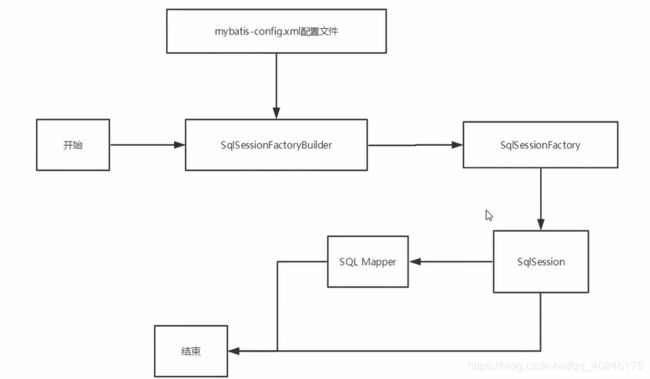
作用域和生命周期类是至关重要的,因为错误的使用会导致非常严重的并发问题。
SqlSessionFactoryBuilder:
- 一旦创建了 SqlSessionFactory,就不再需要它了。
- 局部变量
SqlSessionFactory:
- 说白了就是可以想象为:数据库连接池
- SqlSessionFactory 一旦被创建就应该在应用的运行期间一直存在,没有任何理由丢弃它或重新创建另一个实例。
- SqlSessionFactory 的最佳作用域是应用作用域。
- 最简单的就是使用单例模式或者静态单例模式。保证全局只有一份变量。
SqlSession:
- 连接到连接池的一个请求
- SqlSession 的实例不是线程安全的,因此是不能被共享的,所以它的最佳的作用域是请求或方法作用域。
- 用完之后就赶紧关闭,否则资源被占用。

这里面的每一个Mapper,就代表一个具体的业务!
5.解决属性名和字段名不一致的问题
5.1、问题
数据库中的字段

新建一个项目,拷贝之前的防出错,测试实体类字段不一致的情况

解决方法:
- 起别名:如:
<select id="getUserById" parameterType="int" resultType="User">
select id,name,pwd as password from mybatis.user where id =#{id}
select>
5.2、resultMap
- resultMap 元素是 MyBatis 中最重要最强大的元素。
- ResultMap 的设计思想是,对于简单的语句根本不需要配置显式的结果映射,而对于复杂一点的语句只需要描述它们的关系就行了。
- ResultMap最优秀的地方在于,虽然你已经对它相当了解了,但是根本就不需要显式地用到他们。
- 如果世界总是这么简单就好了。
6、日志
日志工厂
如果一个数据库操作,出现了异常,我们需要排错。日志就是最好的帮手。
曾经有:sout、debug调试
现在:日志工厂

- SLF4J
- LOG4J(重点掌握)
- LOG4J2
- JDK_LOGGING
- COMMONS_LOGGING
- STDOUT_LOGGING(重点掌握)
- NO_LOGGING
在Mybatis中具体使用哪个日志实现,在设置中设定。
STDOUT_LOGGING标准日志输出
在mybatis的核心配置文件中配置
<settings>
<setting name="logImpl" value="STDOUT_LOGGING"/>
settings>
6.2、Log4j
什么是log4j?
- Log4j是Apache的一个开源项目,通过使用Log4j,我们可以控制日志信息输送的目的地是控制台、文件
- 我们也可以控制每一条日志的输出格式
- 通过定义每一条日志信息的级别,我们能够更加细致地控制日志的生成过程
- 通过一个配置文件来灵活地进行配置,而不需要修改应用的代码。
1.先导入log4j的包
<dependency>
<groupId>log4jgroupId>
<artifactId>log4jartifactId>
<version>1.2.17version>
dependency>
2.log4j.properties
#将等级为加EBUG的日志信息输出到console file这两个目的地,console file的定义在下面的代码
log4j.rootLogger=DEBUG,console,file
#控制合输出的相关设置
log4j.appender.console=org.apache.log4j.ConsoleAppender
log4j.appender.console.Target=System.out
log4j.appender.console.Threshold=DEBUG
log4j.appender.console.layout=org.apache.log4j.PatternLayout
log4j.appender.console.layout.ConversionPattern=[%c]-%m%n
#文件输出的相关设置
log4j.appender.file=org.apache.log4j.RollingFileAppender
l0g4j.appender.file.File=./log/biubiubiu.log
log4j.appender.file.MaxFileSize=l0mb
log4j.appender.file.Threshold=DEBUG
log4j.appender.file.layout=org.apache.log4j.PatternLayout
log4j.appender.file.layout.ConversionPattern=[%p][%d{yy-MM-dd}][%c]%m%n
#日志输出级别
log4j.logger.org.mybatis=DEBUG
log4j.logger.java.sql=DEBUG
log4j.logger.java.sql.Statement=DEBUG
log4j.logger.java.sql.ResultSet=DEBUG
log4j.logger.java.sql.PreparedStatement=DEBUG
3.配置log4j为日志的实现
<settings>
<setting name="logImpl" value="LOG4J"/>
settings>
- 在要使用Log4j 的类中,导入org.apache.log4j.Logger;
- 日志对象,加载参数为当前类的class
static Logger logger = Logger.getLogger(UserMapperTest.class); - 日志级别
logger.info("info:进入了testLog4j方法"); logger.debug("debug:进入了testLog4j"); logger.error("error:进入了testLog4j");
7、分页
思考:为什么要分页?
- 减少数据的处理量
7.1、使用Limit分页
select * from user limit startIndex,pageSize
使用Mybatis实现分页,核心SQL
-
接口
//分页查询用户 List<User> getUserByLimit(Map<String,Integer> map); -
Mapper.xml
<select id="getUserByLimit" parameterType="map" resultType="User"> select * from mybatis.user limit #{startIndex},#{pageSize} select> -
测试
@Test public void getUserByLimit(){ SqlSession sqlSession = MyBatisUtils.getSqlSession(); UserMapper mapper = sqlSession.getMapper(UserMapper.class); HashMap<String, Integer> map = new HashMap<>(); map.put("startIndex",0); map.put("pageSize",2); List<User> userList = mapper.getUserByLimit(map); for (User user : userList) { System.out.println(user); } sqlSession.close(); }
7.2、RowBounds分页
不再使用SQL实现分页
-
接口
List<User> getUserByRowBounds(); -
mapper.xml
<select id="getUserByRowBounds" resultMap="UserMap"> select * from user select> -
测试
@Test public void getUserByRowBounds(){ SqlSession sqlSession = MybatisUtils.getSqlSession(); //通过RowBounds实现分页 RowBounds rowBounds = new RowBounds(1, 2); //通过java代码层面实现分页,可查看带有RowBounds参数的方法 List<User> userList = sqlSession.selectList("com.biubiubiu.dao.UserMapper.getUserByRowBounds",null,rowBounds); for (User user : userList) { System.out.println(user); } sqlSession.close(); }
7.3、分页插件
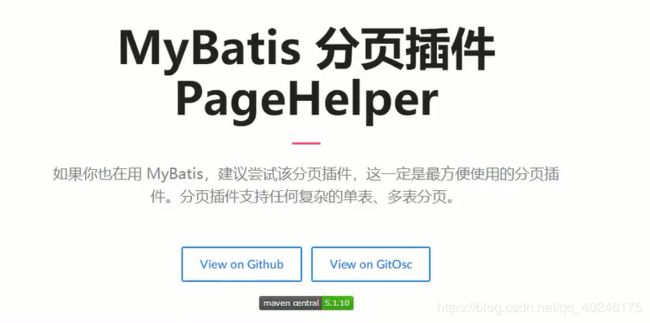
了解即可,万一以后公司的架构师,说要使用,只需要知道它是什么东西!
8、使用注解开发
8.1、面向接口编程
- 大家之前都学过面向对象编程,也学习过接口,但在真正的开发中,很多时候我们会选择面向接口编程
- 根本原因:=解耦=,可拓展,提高复用,分层开发中,上层不用管具体的实现,大家都遵守共同的标准,使得开发变得容易,规范性更好
- 在一个面向对象的系统中,系统的各种功能是由许许多多的不同对象协作完成的。在这种情况下,各个对象内部是如何实现自己的,对系统设计人员来讲就不那么重要了;
- 而各个对象之间的协作关系则成为系统设计的关键。小到不同类之间的通信,大到各模块之间的交互,在系统设计之初都是要着重考虑的,这也是系统设计的主要工作内容。面向接口编程就是指按照这种思想来编程。
关于接口的理解
- 接口从更深层次的理解,应是定义(规范,约束)与实现(名实分离的原则)的分离。
- 接口的本身反映了系统设计人员对系统的抽象理解。
- 接口应有两类:
- 第一类是对一个个体的抽象,它可对应为一个抽象体(abstract class);
- 第二类是对一个个体某一方面的抽象,即形成一个抽象面(interface);一个体有可能有多个抽象面。抽象体与抽象面是有区别的。
三个面向区别
- 面向对象是指,我们考虑问题时,以对象为单位,考虑它的属性及方法.
- 面向过程是指,我们考虑问题时,以一个具体的流程(事务过程)为单位,考虑它的实现.
- 接口设计与非接口设计是针对复用技术而言的,与面向对象(过程)不是一个问题.更多的体现就是对系统整体的架构
8.2、使用注解开发
-
注解在接口上实现
@Select(value = "select * from user") List<User> getUsers(); -
需要在核心配置文件中绑定接口!
<mappers> <mapper class="com.biubiubiu.dao.UserMapper"/> mappers> -
测试
public class UserMapperTest {
@Test
public void test(){
SqlSession sqlSession = MyBatisUtils.getSqlSession();
//底层主要应用反射
UserMapper mapper = sqlSession.getMapper(UserMapper.class);
List<User> users = mapper.getUsers();
for (User user : users) {
System.out.println(user);
}
sqlSession.close();
}
}
本质:反射机制实现
底层:动态代理!

Mybatis详细的执行流程!!
个人总结Mybatis底层代码原理分析流程图
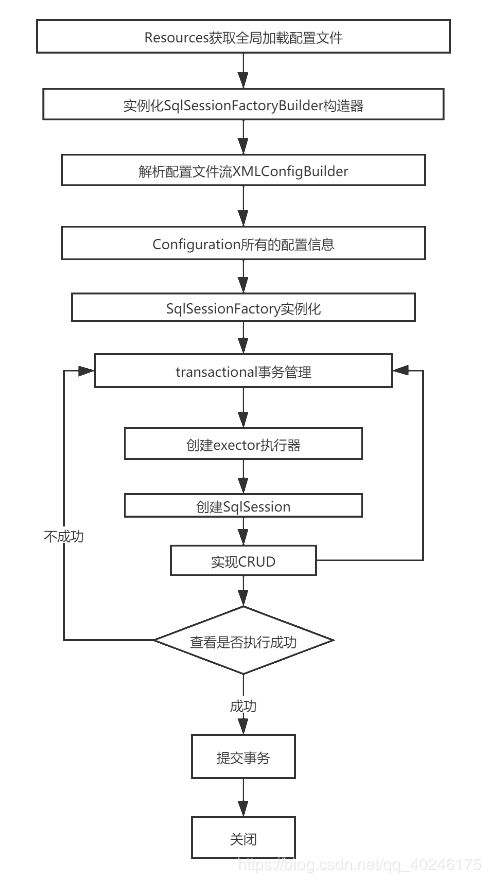
8.3、CRUD
其实Mybatis的注解开发不是很重要,一般都会使用xml配置。注解了解即可。
我们可以在工具类创建的时候实现自动提交事务!
public static SqlSession getSqlSession(){
return sqlSessionFactory.openSession(true);
}
编写接口,增加注解
public interface UserMapper {
@Select("select * from user")
List<User> getUsers();
/**
*方法存在多个参数,所有的参数前面必须加上@Parma注解
*/
@Select("select * from user where id = #{id}")
User getUserByID(@Param("id")int id);
@Insert("insert into user(id,name,password) values (#{id},#{name},#{password})")
int addUser(User user);
@Update("update user set name=#{name}, password=#{password} where id=#{id}")
int updateUser(User user);
@Delete("delete from user where id=#{id}")
int deleteUser(@Param("id")int id);
}
测试类
@Test
public void test(){
SqlSession sqlSession = MybatisUtils.getSqlSession();
//底层主要应用反射实现
UserMapper mapper = sqlSession.getMapper(UserMapper.class);
List<User> userList = mapper.getUsers();
for (User user : userList) {
System.out.println(user);
}
System.out.println("----------------------");
User user = mapper.getUserByID(1);
System.out.println(user);
System.out.println("----------------------");
int i = mapper.addUser(new User(7, "田七", "77777"));
if(i>0){
System.out.println("添加成功");
}
System.out.println("----------------------");
int i1 = mapper.updateUser(new User(5, "王五五五", "5555555555"));
if(i1>0){
System.out.println("修改成功");
}
System.out.println("----------------------");
int i2 = mapper.deleteUser(5);
if(i2>0){
System.out.println("删除成功");
}
System.out.println("----------------------");
sqlSession.close();
}
【注意:我们必须要将接口注册绑定到我们的核心配置文件中!】
<!--注解开发->绑定接口-->
<mappers>
<mapper class="com.biubiubiu.dao.UserMapper"/>
</mappers>
关于@Param()注解
- 基本类型的参数或者String类型,需要加上
- 引用类型不需要加
- 如果只有一个基本类型的话,可以忽略,但是建议大家都加上
- 我们在SQL中引用的就是我们这里的@Param()中设定的属性名
9、Lombok
Project Lombok is a java library that automatically plugs into your editor and build tools, spicing up your java.
Never write another getter or equals method again, with one annotation your class has a fully featured builder, Automate your logging variables, and much more.
使用步骤:
-
在IDEA中安装Lombok插件
-
在项目中导入lombok的jar包
<dependency> <groupId>org.projectlombokgroupId> <artifactId>lombokartifactId> <version>1.18.10version> dependency> -
在实体类上加注解即可
@Getter and @Setter @FieldNameConstants @ToString @EqualsAndHashCode @AllArgsConstructor, @RequiredArgsConstructor and @NoArgsConstructor @Log, @Log4j, @Log4j2, @Slf4j, @XSlf4j, @CommonsLog, @JBossLog, @Flogger, @CustomLog @Data @Builder @SuperBuilder @Singular @Delegate @Value @Accessors @Wither @With @SneakyThrows @val @var experimental @var @UtilityClass Lombok config system
说明:
@Data:无参构造,get、set、toSring、hashcode、equals
@AllArgsConstructor
@NoArgsConstructor
@ToString
@EqualsAndHashCode
10、多对一处理
多对一:
CREATE TABLE `teacher`(
`id` int(10) Not null,
`name` VARCHAR(30) DEFAULT NULL,
PRIMARY KEY (`id`)
)ENGINE=INNODB DEFAULT CHARSET=utf8;
INSERT INTO teacher(`id`,`name`) VALUES (1,'秦老师');
CREATE TABLE `student`(
`id` int(10) Not null,
`name` VARCHAR(30) DEFAULT NULL,
`tid` INT(10) DEFAULT NULL,
PRIMARY KEY (`id`),
KEY `fktid`(`tid`),
CONSTRAINT `fktid` FOREIGN KEY (`tid`) REFERENCES `teacher` (`id`)
)ENGINE=INNODB DEFAULT CHARSET=utf8;
INSERT INTO student(`id`,`name`,`tid`) VALUES (1,'小明',1);
INSERT INTO student(`id`,`name`,`tid`) VALUES (2,'小红',1);
INSERT INTO student(`id`,`name`,`tid`) VALUES (3,'小张',1);
INSERT INTO student(`id`,`name`,`tid`) VALUES (4,'小李',1);
INSERT INTO student(`id`,`name`,`tid`) VALUES (5,'小王',1);
测试环境
- 导入lombok
- 新建实体类Teacher,Student
- 新建Mapper接口
- 建立Mapper.XML文件
- 在核心配置文件中绑定注册我们的MApper接口或者文件!【方式很多,随意选】
个人觉得直接绑定包,是最方便的。。
<mappers>
<!--绑定类,只能单个绑定-->
<!--<mapper class="com.biubiubiu.dao.TeacherMapper"/>
<mapper class="com.biubiubiu.dao.StudentMapper"/>-->
<!--绑定xml文件,也只能单个绑定-->
<!--<mapper resource="com/biubiubiu/dao/TeacherMapper.xml"/>
<mapper resource="com/biubiubiu/dao/StudentMapper.xml"/>-->
<!--绑定包,包下所有,方便-->
<!--接口绑定,声明包,方便扫描接口和mapper.xml-->
<package name="com.biubiubiu.dao"/>
</mappers>
- 测试查询是否成功!
按照查询嵌套处理
<mapper namespace="com.biubiubiu.dao.StudentMapper">
<select id="getStudent" resultMap="StudentTeacher">
/*select s.id,s.name,t.name from student as s,teacher as t where s.tid=t.id*/
select * from student
select>
<resultMap id="StudentTeacher" type="Student">
<result property="id" column="id"/>
<result property="name" column="name"/>
<association property="teacher" column="tid" javaType="Teacher" select="com.biubiubiu.dao.TeacherMapper.getTeacher"/>
resultMap>
mapper>
按照结果嵌套处理
<resultMap id="StudentTeacher2" type="Student">
<result property="id" column="sid"/>
<result property="name" column="sname"/>
<association property="teacher" javaType="Teacher">
<result property="name" column="tname"/>
association>
resultMap>
<select id="getStudent2" resultMap="StudentTeacher2">
select s.id as sid,s.name as sname,t.name as tname
from student as s,teacher as t
where s.tid=t.id
select>
回顾Mysql多对一查询方式:
- 子查询
- 联表查询
11、一对多处理
比如:一个老师拥有多个学生!
对于老师而言,就是一对多的关系!
环境搭建
- 环境搭建,和刚才一样
实体类
@Data
public class Teacher {
private int id;
private String name;
//一个老师拥有多个学生
private List<Student> students;
}
@Data
public class Student {
private int id;
private String name;
private int tid;
}
按照结果嵌套处理
<select id="getTeacher" resultMap="TeacherStudent">
select s.id sid, s.name sname, t.name tname, t.id tid
from student s, teacher t
where s.tid=t.id and t.id =#{tid}
select>
<resultMap id="TeacherStudent" type="Teacher">
<result property="id" column="tid"/>
<result property="name" column="tname"/>
<collection property="students" ofType="Student">
<result property="id" column="sid"/>
<result property="name" column="sname"/>
<result property="tid" column="sid"/>
collection>
resultMap>
按照查询嵌套处理
<select id="getTeacher2" resultMap="TeacherStudent2">
select * from teacher where id =#{tid}
select>
<resultMap id="TeacherStudent2" type="Teacher">
<collection property="students" javaType="ArrayList" ofType="Student" select="com.biubiubiu.dao.StudentMapper.getStudentByTeacherId" column="id"/>
resultMap>
小节
- 关联-association【多对一】
- 集合-collection 【一对多】
- javaType & ofType
- JavaType用来指定实体类中属性的类型
- ofType用来指定映射到List或者集合中的pojo类型,泛型中的约束类型!
注意点:
- 保证SQL的可读性,尽量保证通俗易懂
- 注意一对多和多对一中,属性名和字段的问题!
- 如果问题不好排查错误,可以使用日志,建议使用Log4j
慢SQL: 人家查只要1S 你查要1000S 你GG
面试高频
- Mysql引擎
- InnoDB底层原理
- 索引
- 索引优化!
12、动态SQL
什么是动态SQL:动态SQL就是指根据不同的条件生成不同的SQL语句。
- MyBatis 的强大特性之一便是它的动态 SQL。如果你有使用 JDBC 或其它类似框架的经验,你就能体会到根据不同条件拼接 SQL 语句的痛苦。例如拼接时要确保不能忘记添加必要的空格,还要注意去掉列表最后一个列名的逗号。利用动态 SQL 这一特性可以彻底摆脱这种痛苦。
动态 SQL 元素和 JSTL 或基于类似 XML 的文本处理器相似。在 MyBatis 之前的版本中,
有很多元素需要花时间了解。MyBatis 3 大大精简了元素种类,现在只需学习原来一半的
元素便可。MyBatis 采用功能强大的基于 OGNL 的表达式来淘汰其它大部分元素。
if
choose (when, otherwise)
trim (where, set)
foreach
搭建环境
CREATE TABLE `blog`(
`id` VARCHAR(50) NOT NULL COMMENT '博客id',
`title` VARCHAR(100) not null comment '博客标题',
`author` VARCHAR(30) not null comment '博客作者',
`create_time` datetime not null comment '创建时间',
`views` int(30) not null comment '浏览量'
)ENGINE=InnoDB DEFAULT CHARSET=utf8
创建一个基础工程
-
导包
-
编写配置文件
-
编写实体类
/**
* @author biubiubiu
*/
@Data
@AllArgsConstructor
@NoArgsConstructor
public class Blog {
private int id;
private String title;
private String author;
private Date createTime;
private int views;
}
- 编写实体类对应的Mapper接口和Mapper.xml
测试连接
/**
* @author biubiubiu
*/
public interface BlogMapper {
/**
*插入博客数据
* @param blog
* @return
*/
int addBlog(Blog blog);
/**
* 查询博客动态IF
* @param map
* @return
*/
List<Blog> queryBlogIF(Map map);
/**
* 查询博客动态Choose
* @param map
* @return
*/
List<Blog> queryBlogChoose(Map map);
/**
* 更新博客动态SET
* @param map
* @return
*/
int queryBlog(Map map);
/**
* 查询第1/2/3号记录的博客:foreach
* @param map
* @return
*/
List<Blog> queryBlogForeach(Map map);
}
<mapper namespace="com.biubiubiu.dao.BlogMapper">
<insert id="addBlog" parameterType="blog">
insert into blog (id, title, author, create_time, views)
values (#{id}, #{title}, #{author}, #{createTime}, #{views})
insert>
mapper>
动态IF
<select id="queryBlogIF" parameterType="map" resultType="blog">
select * from blog where 1=1
<if test="title!=null">
and title=#{title}
if>
<if test="author!=null">
and author=#{author}
if>
select>
@Test
public void queryBlogIF(){
SqlSession sqlSession = MybatisUtils.getSqlSession();
BlogMapper mapper = sqlSession.getMapper(BlogMapper.class);
Map map = new HashMap();
List<Blog> blogs = mapper.queryBlogIF(map);
for (Blog blog : blogs) {
System.out.println(blog);
}
System.out.println("*************分割*************");
Map map1 = new HashMap();
map1.put("title","Mybatis is so easy~");
List<Blog> blogs1 = mapper.queryBlogIF(map1);
for (Blog blog : blogs1) {
System.out.println(blog);
}
System.out.println("*************分割*************");
Map map2 = new HashMap();
map2.put("title","Spring is so easy~");
map2.put("author","biubiubiu!");
List<Blog> blogs2 = mapper.queryBlogIF(map2);
for (Blog blog : blogs2) {
System.out.println(blog);
}
sqlSession.close();
}
动态choose (when, otherwise)
<select id="queryBlogChoose" parameterType="map" resultType="blog">
select * from blog
<where>
<choose>
<when test="title != null">
title=#{title}
when>
<when test="author!=null">
and author = #{author}
when>
<otherwise>
and views = #{views}
otherwise>
choose>
where>
select>
动态trim, (where, set)
select * from mybatis.bolg
<where>
<if test="title != null">
title = #{title}
if>
<if test="author != null">
and author = #{author}
if>
where>
<update id="updateBlog" parameterType="map">
update blog
<set>
<if test="title != null">
title = #{title},
if>
<if test="author != null">
author = #{author},
if>
set>
where id = #{id}
update>
所谓的动态SQL,本质还是SQL语句,只是我们可以在SQL层面,去执行一些逻辑代码
if
Where,set,choose,when
SQL片段
有的时候,我们可能会将一些公共的部分抽取出来,方便复用!
-
使用SQL标签抽取公共的部分
<sql id="if-title-author"> <if test="title != null"> title = #{title} if> <if test="author != null"> and author = #{author} if> sql> -
在需要使用的地方使用Include标签引用即可
<select id="queryBlogIF" parameterType="map" resultType="blog"> select * from blog <where> <include refid="if-title-author"/> where> select>注意事项:
- 最好基于单表来定义SQL片段!
- 不要存在where或者set标签,片段里尽量只有if就好了
Foreach
select * from user where 1=1 and
<foreach item="id" index="index" collection="ids"
open="(" separator="or" close=")">
#{id}
</foreach>
(id=1 or id=2 or id=3)
<select id="queryBlogForeach" parameterType="map" resultType="Blog">
select * from mybatis.bolg
<where>
<foreach collection="ids" item="id" open="(" close=")" separator="or">
id = #{id}
foreach>
where>
select>
动态SQL就是在拼接SQL语句,我们只要保证SQL的正确性,按照SQL的格式,去排列组合就可以了
建议:先在Mysql中写出完整的SQL,在对应的去修改成为我们的动态SQL,实现通用即可。
13、缓存(了解)
13.1、简介
查询 : 连接数据库,耗资源!
一次查询的结果,给他暂存在一个可以直接取到的地方!--->内存 : 缓存
我们再次查询相同数据的时候,直接走缓存,就不用走数据库了
-
什么是缓存[Cache]?
-
存在内存中的临时数据。
-
将用户经常查询的数据放在缓存(内存)中,用户去查询数据就不用从磁盘上(关系型数据库数据文件)查询,
从缓存中查询,从而提高查询效率,解决了高并发系统的性能问题。
-
-
为什么使用缓存?
- 减少和数据库的交互次数,减少系统开销,提高系统效率。
-
什么样的数据能使用缓存?
- 经常查询并且不经常改变的数据。【可以使用缓存】
13.2、Mybatis缓存
- MyBatis包含一个非常强大的查询缓存特性,它可以非常方便地定制和配置缓存。缓存可以极大的提升查询效率。
- MyBatis系统中默认定义了两级缓存:一级缓存和二级缓存
- 默认情况下,只有一级缓存开启。(SqlSession级别的缓存,也称为本地缓存)
- 二级缓存需要手动开启和配置,他是基于namespace级别的缓存。
- 为了提扩展性,MyBatis定义了缓存接口Cache。我们可以通过实现Cache接口来自定义二级缓存
13.3、一级缓存
- 一级缓存也叫本地缓存:SqlSession
- 与数据库同义词会话期间查询到的数据会放在本地缓存中。
- 以后如果需要获取相同的数据,直接从缓存中拿,没有必要再去查询数据;
测试步骤:
- 开启日志!
<settings>
<setting name="logImpl" value="STDOUT_LOGGING"/>
settings>
- 测试在一个Session中查询两次相同的记录
@Test
public void test(){
/**
* 这两次查询,查询的id一样,只创建了一次连接,进行了一次会话SqlSession
*/
SqlSession sqlSession = MybatisUtils.getSqlSession();
UserMapper mapper = sqlSession.getMapper(UserMapper.class);
User user = mapper.queryUserById(1);
System.out.println(user);
System.out.println("******************");
User user1 = mapper.queryUserById(1);
System.out.println(user1);
System.out.println(user==user1);
sqlSession.close();
}
缓存失效的情况:
-
查询不同的东西
-
增删改操作,可能会改变原来的数据,所以必定会刷新缓存!
-
查询不同的Mapper.xml
-
手动清理缓存!
@Test
public void test(){
/**
* 这两次查询只创建了一次连接,进行了一次会话SqlSession
*/
SqlSession sqlSession = MybatisUtils.getSqlSession();
UserMapper mapper = sqlSession.getMapper(UserMapper.class);
User user = mapper.queryUserById(1);
System.out.println(user);
/**
* 手动清理缓存,清理缓存,再查第二次的时候,就会再进行连接
*/
sqlSession.clearCache();
System.out.println("******************");
User user1 = mapper.queryUserById(1);
System.out.println(user1);
System.out.println(user==user1);
sqlSession.close();
}
小节:一级缓存默认是开启的,只在一次SqlSession中有效,也就是拿到连接到关闭连接这个区间段!
一级缓存就是一个Map。
13.4、二级缓存
- 二级缓存也叫全局缓存,一级缓存作用域太低了,所以诞生了二级缓存
- 基于namespace级别的缓存,一个名称空间,对应一个二级缓存;
- 工作机制
- 一个会话查询一条数据,这个数据就会被放在当前会话的一级缓存中;
- 如果当前会话关闭了,这个会话对应的一级缓存就没了;但是我们想要的是,会话关闭了,一级缓存中的数据会被保存到二级缓存中;
- 新的会话查询信息,就可以从二级缓存中获取内容;
- 不同的mapper查出的数据会放在自己对应的缓存(map)中;
步骤:
-
开启全局缓存
<setting name="cacheEnabled" value="true"/> -
在要使用二级缓存的Mapper中开启
<cache/> 也可以自定义参数 <cache eviction="FIFO" flushInterval="60000" size="512" readOnly="true"/> -
测试
-
问题:我们需要将实体类序列化!否则就会报错
java.io.NotSerializableException: com.rui.pojo.User
-
小结:
- 只要开启了二级缓存,在同一个Mapper下就有效
- 所有的数据都会先放在一级缓存中;
- 只有当会话提交,或者关闭的时候,才会提交到二级缓存中!
13.5、缓存原理
13.6、自定义缓存-encache
EhCache 是一个纯Java的进程内缓存框架,具有快速、精干等特点,是Hibernate中默认的CacheProvider。
要在程序中使用ehcache,先要导包!
<dependency>
<groupId>org.mybatis.cachesgroupId>
<artifactId>mybatis-ehcacheartifactId>
<version>1.1.0version>
dependency>
然后在mapper中指定使用ehcache缓存实现
<cache type="org.mybatis.caches.ehcache.EhcacheCache"/>
导入配置文件 ehcache.xml
<ehcache xmlns:xsi="http://www.w3.org/2001/XMLSchema-instance"
xsi:noNamespaceSchemaLocation="http://ehcache.org/ehcache.xsd"
updateCheck="false">
<diskStore path="java.io.tmpdir/Tmp_EhCache"/>
<defaultCache
eternal="false"
maxElementsInMemory="10000"
overflowToDisk="false"
diskPersistent="false"
timeToIdleSeconds="1800"
timeToLiveSeconds="259200"
memoryStoreEvictionPolicy="LRU"/>
<cache
name="cloud_user"
eternal="false"
maxElementsInMemory="5000"
overflowToDisk="false"
diskPersistent="false"
timeToIdleSeconds="1800"
timeToLiveSeconds="1800"
memoryStoreEvictionPolicy="LRU"/>
ehcache>
能一直看到这,我觉得对你应该会有帮助。
请多多支持博主,点赞关注哦~~



